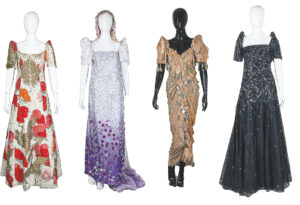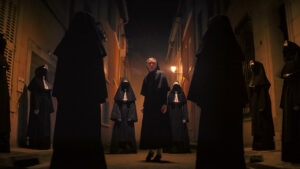The terno keeps its relevance through the centuries

A BEQUEST of 40 ternos forms the nucleus for an exhibit at the De La Salle University – College of St. Benilde (CSB), but also a future costume institute.
When fashion designer Ben Farrales (dubbed the Dean of Philippine Fashion) died in 2021, his family thought it best to donate 40 pieces from his collection of ternos to aid the fashion design program of CSB. However, after they were exhibited last year, “Suddenly, when word got around that we were accepting couture pieces of noted Filipino designers, a lot of donors messaged us and came forward,” said architect Gerry Torres, curator and Director for the Center for Campus Art for CSB in an interview during the opening of the exhibition titled “Fashion, Power, Modernity: The Ternos of the Benilde Collection” last week.
“When the family saw that, and also the friends of Mang Ben (as Mr. Farrales was called by his clients), they said, (they) might just as well give the rest of the collection to Benilde, because they’re going to take care of it.”
Mr. Torres points out that the clothes are stored in a climate-controlled room, laid flat in boxes lined with acid-free paper (or else, folded exactly once to reduce the risk of crumpling). They are sometimes taken out to be hung to preserve their form, during which they are photographed and documented, and a report is written up on the condition of the clothing.
The Farrales family increased their donation from 40 pieces to 200, forming the bulk of the collection. Adding to the mix are ternos made for former first lady Luz Banzon-Magsaysay, some made by master Ramon Valera, the first Filipino fashion designer recognized as a National Artist. These were donated by her daughter, Milagros Magsaysay-Valenzuela. Other terno bequests were made by the late designers Aureo Alonzo and Pitoy Moreno, and some donated by socialites Conchitina Sevilla-Bernardo, Bambi Harper, and Vicky Rodriguez.
There is of course a marvelous gold lace terno made by Mr. Farrales, but also a number with a blue bodice and a frothy white skirt by Pitoy Moreno. Mrs. Magsaysay’s wonderfully draped and pleated white terno with crystals and mother-of-pearl by Ramon Valera stands in a corner. An elegantly somber black terno, also by Mr. Moreno, is in the exhibit, a gift from Ms. Sevilla-Bernardo. There are about 30 dresses on show.
From treasured memories of evenings past, these dresses now become a part of history. “I think they realized that what they have in their closets are valuable artifacts for fashion design education,” said Mr. Torres. “Instead of keeping them in their closet and no one will see them, no one will wear them again, I think these donors saw fit that if they would be used for the education of future generations of fashion designers, then why not?”
These bequests are paving the way for a future fashion and costume design institute by CSB. The former art deco Instituto Cervantes building at the corner of Leon Guinto and Estrada has already been earmarked for the project, and Mr. Torres says that they hope to open by next year.
THE TERNO, A HISTORYThe terno follows a relatively uninterrupted line of clothes dating back to pre-colonial times in the Philippines. The chemise and skirt combinations were worn by native Filipinos, in a number of combinations from the baro (a top), a tapis (cloth used as a skirt or apron), and the malong (a cylindrical garment that can be worn on the top or bottom) evolving into the kamisa (note the change in language, the word borrowed and changed from Europe) and the baro’t saya. The longer the Spaniards stayed here (the 1500s to the 1800s), the clothing continued to evolve, culminating in the traje de mestiza, which was the baro’t saya with a panuelo and huge sleeves, picking up influences from native dress, and fashions from Europe in the late 1700s to the 1800s.
The American occupation streamlined this dress, slowly melding all the elements together. By the 1930s, the look had been streamlined into what we now recognize as the terno — butterfly sleeves on a western-style gown, but still with vestiges of the panuelo (a triangular fichu). By the postwar period, thanks to the innovations of designers like Salvacion Lim Higgins, and fashionable Filipinas, the panuelo had been abandoned. Through war, privation and regime changes, Filipinas stubbornly held on to their big butterfly sleeves. While former first ladies Mrs. Magsaysay and Eva Macaraeg Macapagal contributed to the change in formal Filipiniana fashion, the terno in its most evolved form, and the pattern by which most designers base their designs today, were worn during the time of former first lady and dictator’s wife Imelda Marcos.
The exhibit represents some of the best gowns made not only in the Philippines, but arguably in the world. It’s one thing to be taught how to make a terno (in the exhibit, a guide illustrating how to make the sleeves greet a visitor), but to be exposed to the best, well: “In this gallery, you have an example of the highest levels of clothing construction,” said Mr. Torres. “For me, it is a good example of how something so basic” — here he points out that only the sleeves actually make the garment distinct — “Yet in the hands of these four great designers, they have been turned into works of art.”
“I am hoping that the next generation of Filipino fashion designers will be able to also create as innovatively and inventively the terno: re-create the terno as much as these four designers have done,” he said.
The terno is now more popular than ever. While associations with Mrs. Marcos may have put a damper on the terno for decades after the 1986 EDSA revolution, they slowly returning by the middle of the 1990s. Dress codes at weddings, formals, and state events made the terno indelible, and efforts like clothing brand Bench’s Ternocon keep the tradition alive for designers in the country. Still, this wouldn’t be possible without demand, so why do Filipinas still want to wear the terno?
“Filipinas realize that if you’re Pinoy, you will always look good in a terno,” said Mr. Torres. “The terno is designed in such a way — it’s open — to show your neck. The butterfly sleeves add height, presence, to the person wearing it. For the rest, you can do something. Anything.”
“Any Filipina can wear and feel comfortable and beautiful wearing it. It doesn’t have to be worn by somebody incredibly tall, or thin. I think in all shapes and sizes of a Filipina, the terno will still flatter her.”
“Fashion, Power, Modernity: The Ternos of the Benilde Collection” is now open to the public at the 12F Gallery of Benilde Design + Arts Campus until Friday, Dec. 15. — Joseph L. Garcia




